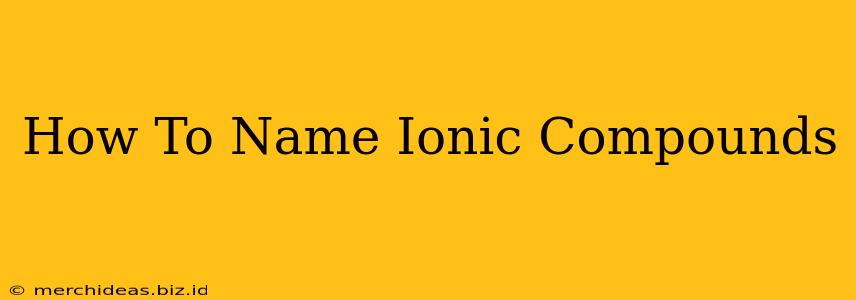Naming ionic compounds might seem daunting at first, but with a structured approach, it becomes straightforward. This guide will break down the process step-by-step, equipping you with the knowledge to confidently name any ionic compound.
Understanding Ionic Compounds
Before diving into naming conventions, let's establish a foundational understanding. Ionic compounds are formed through the electrostatic attraction between positively charged ions (cations) and negatively charged ions (anions). This strong attraction results in a neutral compound. The key to naming them lies in identifying these ions and their charges.
Identifying Cations and Anions
-
Cations: These are positively charged ions, typically formed by metals losing electrons. Common examples include sodium (Na⁺), potassium (K⁺), calcium (Ca²⁺), and iron (Fe²⁺ or Fe³⁺).
-
Anions: These are negatively charged ions, usually formed by nonmetals gaining electrons. Common examples include chloride (Cl⁻), oxide (O²⁻), sulfide (S²⁻), and nitrate (NO₃⁻).
Naming Monatomic Ionic Compounds
Monatomic ionic compounds contain ions composed of only one atom. Naming these is relatively simple:
Step 1: Name the Cation
The cation (positive ion) is named first, using the element's name. For example, Na⁺ is sodium, K⁺ is potassium, and Ca²⁺ is calcium. Transition metals, however, can have multiple oxidation states (charges), requiring Roman numerals to indicate the charge. For instance, Fe²⁺ is iron(II) and Fe³⁺ is iron(III).
Step 2: Name the Anion
The anion (negative ion) is named second, using the root name of the element with the suffix "-ide" added. For example:
- Cl⁻ is chloride
- O²⁻ is oxide
- S²⁻ is sulfide
- N³⁻ is nitride
- P³⁻ is phosphide
Example: Naming NaCl
Sodium chloride (NaCl) is named as follows:
- Cation: Sodium (Na⁺)
- Anion: Chloride (Cl⁻)
Therefore, the name of the compound is sodium chloride.
Naming Polyatomic Ionic Compounds
Polyatomic ions are groups of atoms that carry a net charge. These require a slightly different approach:
Common Polyatomic Anions
Familiarize yourself with common polyatomic anions, as these frequently appear in ionic compounds. Some examples include:
- Nitrate (NO₃⁻): Found in fertilizers and explosives.
- Sulfate (SO₄²⁻): A common component of many salts.
- Phosphate (PO₄³⁻): Essential for biological systems.
- Hydroxide (OH⁻): Found in bases and many cleaning products.
- Carbonate (CO₃²⁻): Present in many minerals and rocks.
- Ammonium (NH₄⁺): A positively charged polyatomic ion.
Naming Procedure
The naming procedure remains similar to monatomic compounds:
- Name the Cation: As before, use the element's name (including Roman numerals for transition metals).
- Name the Anion: Use the name of the polyatomic anion. Do not modify it with "-ide."
Example: Naming (NH₄)₂SO₄
Ammonium sulfate ((NH₄)₂SO₄) is named as follows:
- Cation: Ammonium (NH₄⁺)
- Anion: Sulfate (SO₄²⁻)
Therefore, the name is ammonium sulfate.
Tips and Tricks for Success
- Memorize common ions: Creating flashcards or a chart of common cations and anions will significantly speed up the naming process.
- Practice regularly: The more you practice, the more confident you'll become. Work through examples and check your answers.
- Use resources: There are numerous online resources and textbooks that provide additional practice problems and explanations.
Mastering the art of naming ionic compounds is crucial for understanding chemistry. By following these steps and dedicating time to practice, you'll quickly become proficient in this essential skill. Remember to always identify the cation and anion first before applying the appropriate naming rules. Good luck!
